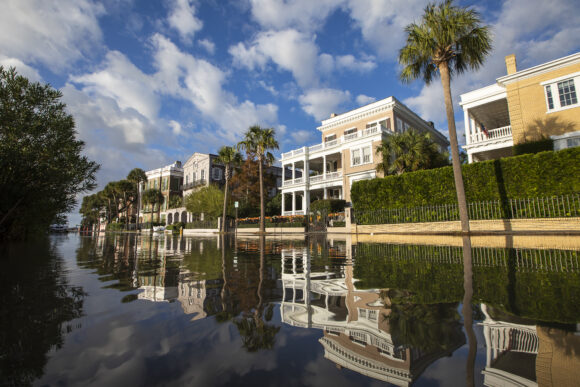CHARLESTON, S.C. (AP)–A plan to build a $1.1 billion seawall around much of downtown Charleston is leaning toward relying on concrete structures, although many would like to see the U.S. Army Corps of Engineers include less intrusive solutions such as living shorelines and enhanced marshes.
The Post and Courier of Charleston obtained public comments through a Freedom of Information Act request. Those comments show residents, nonprofit groups and even the South Carolina Department of Natural Resources all want more natural characteristics included.
“I am seriously concerned that a more naturalistic approach was not the result of this study,” one resident wrote in September.
The 8-mile (12.8-kilometer) project would include a wall rising 8 feet (2.5 meters) above tidal flood levels. The plan includes dozens of gates that would close and block off roads, streams and walkways when a storm approaches. Pumps would push out water when the gates close.
Jaclyn Pennoyer, a spokesperson for the Corps’ Charleston District, wrote in an email that the agency considered three nature-based protections for the city–building living shorelines of oyster reefs, adding sediment to existing marshes and uncovering long-filled tidal creeks.
But none of these options would protect Charleston against hurricane surge of several feet, she wrote. That’s the Corps’ mandate for protection. Some oyster reefs are included in the most recent version of the plan. But they would parallel stretches of the surge wall, not replace it.
Reefs, enhanced marshes or improved creeks “as stand-alone perimeter protection do NOT appreciably reduce the risk of damages from coastal storm surge,” Pennoyer wrote. “Additional nature-based solutions could be included and funded by the City of Charleston to address rainfall and tidal flooding.”
Western Carolina University Professor Robert Young said it’s true that a reef would be drowned by a strong storm surge. But he said said greener strategies would add environmental benefits. And he said storm surge isn’t the only challenge to Charleston. Rising sea levels are already causing more frequent but less severe tidal flooding.
“It’s better to create sort of a multi-layered approach to gray infrastructure than it is to just build a dang seawall,” Young said.
Living shorelines work best at protecting the edge of a marsh or high ground from erosion. South Carolina is now letting landowners install their own versions to protect property or marsh.
In recent years, researchers have started purposefully placing oyster shells and other products to shield marsh, said Peter Kingsley-Smith, a senior marine scientist with the state Department of Natural Resources. Bags of shells, cement “castles,” logs of coconut fiber and even crab traps have all been tried, Kingsley-Smith told the newspaper.
These methods can preserve marsh grasses, which are important wildlife habitats and absorb carbon gases.
The Coastal Conservation League commissioned an alternative Charleston plan that proposes oyster reefs to slow down waves, earthen levees and engineered wetlands in different sections of the city.
Outgoing executive director Laura Cantral acknowledged that’s not enough to stop storm surge. But she argues the wall would work better with those features.
“The Corps’ mandate is to address storm surge, we get that,” she said. “We also believe many of these nature-based solutions make the overall objective of the wall … more effective.”
One issue is that the Corps calculates a cost-benefit ratio to determine which projects are worth paying for. It doesn’t account for benefits from greener options, said Natalie Snider of the Environmental Defense Fund. Congress told the Corps to consider incorporating these elements into plans in 2018 and 2020, she said.
“We’ve just seen the Corps be slow on the uptake of really developing and relying on these features,” Snider said.
The cost-benefit ratio for the Charleston project as now designed is more than 10 to 1, making it one of the most attractive for the federal government to fund in the Southeast.
About the photo: Flood waters reflect East Battery as a king tide rolls into the historic Battery causing flooding in Charleston, S.C. Sunday, Nov. 15, 2020. Charleston has remained relatively unscathed this hurricane season. That means more time to mull a $1.75 billion proposal by the Army Corps of Engineers that features a sea wall along the city’s peninsula to protect it from deadly storm surge during hurricanes. (AP Photo/Mic Smith)
Was this article valuable?
Here are more articles you may enjoy.


 OpenAI And Microsoft Sued Over Murder-Suicide Blamed on ChatGPT
OpenAI And Microsoft Sued Over Murder-Suicide Blamed on ChatGPT  JPMorgan Wins Gender Pay Gap Dispute Against London Analyst
JPMorgan Wins Gender Pay Gap Dispute Against London Analyst  Billionaire NFL Owner Suing Over Billboards Near His SoFi Stadium
Billionaire NFL Owner Suing Over Billboards Near His SoFi Stadium  Tesla, EEOC Plan Talks to Settle Factory Racism Suit
Tesla, EEOC Plan Talks to Settle Factory Racism Suit 